The GeForce GTX 660 Ti Review, Feat. EVGA, Zotac, and Gigabyte
by Ryan Smith on August 16, 2012 9:00 AM ESTOC: Power, Temperature, & Noise
Our final task is our look at the overclocking capabilities of our GTX 660 Ti cards. Based on what we’ve seen thus far with GTX 660 Ti, these factory overclocked parts are undoubtedly eating into overclocking headroom, so we’ll have to see just what we can get out of them. The very similar GTX 670 topped out at around 1260MHz for the max boost clock, and between 6.6GHz and 6.9GHz for the memory clock.
| GeForce 660 Ti Overclocking | |||||
| EVGA GTX 660 Ti SC | Zotac GTX 660 Ti AMP | Gigabyte GTX 660 Ti OC | |||
| Shipping Core Clock | 980MHz | 1033MHz | 1033MHz | ||
| Shipping Max Boost Clock | 1150MHz | 1175MHz | 1228MHz | ||
| Shipping Memory Clock | 6GHz | 6.6GHz | 6GHz | ||
| Shipping Max Boost Voltage | 1.175v | 1.175v | 1.175v | ||
| Overclock Core Clock | 1030MHz | 1033MHz | 1083MHz | ||
| Overclock Max Boost Clock | 1200MHz | 1175MHz | 1278MHz | ||
| Overclock Memory Clock | 6.5GHz | 6.8GHz | 6.6GHz | ||
| Overclock Max Boost Voltage | 1.175v | 1.175v | 1.175v | ||
As we suspected, starting with factory overclocked cards isn’t helping here. Our Zotac card wouldn’t accept any kind of meaningful GPU core overclock, so it shipped practically as fast as it could go. We were able to squeeze out another 200MHz on the memory clock though.
Meanwhile our EVGA and Gigabyte cards fared slightly better. We could push another 50MHz out of their GPU clocks, bringing us to a max boost clock of 1200MHz on the EVGA card and 1278MHz on the Gigabyte card. Memory overclocking was similarly consistent; we were able to hit 6.5GHz on the EVGA card and 6.6GHz on the Gigabyte card.
Altogether these are sub-5% GPU overclocks, and at best 10% memory overclocks, which all things considered are fairly low overclocks. The good news is that reference-clocked cards should fare better since their headroom has not already been consumed by factory overclocking, but binning also means the best cards are going to be going out as factory overclocked models.
Moving on to our performance charts, we’re going to once again start with power, temperature, and noise, before moving on to gaming performance.

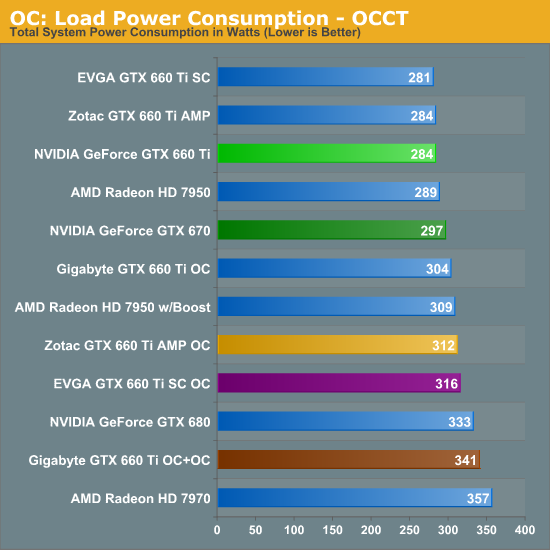
Unsurprisingly, given the small power target difference between the GTX 670 and the GTX 660 Ti, any kind of overclocking that involves raising the power target quickly pushes power consumption past the GTX 670’s power consumption. How much depends on the test and the card, with the higher power target Gigabyte card starting with a particular disadvantage here as its power consumption ends up rivaling that of the GTX 680.
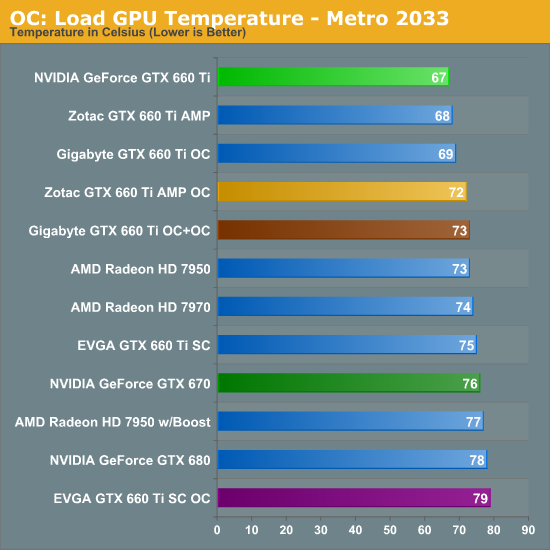
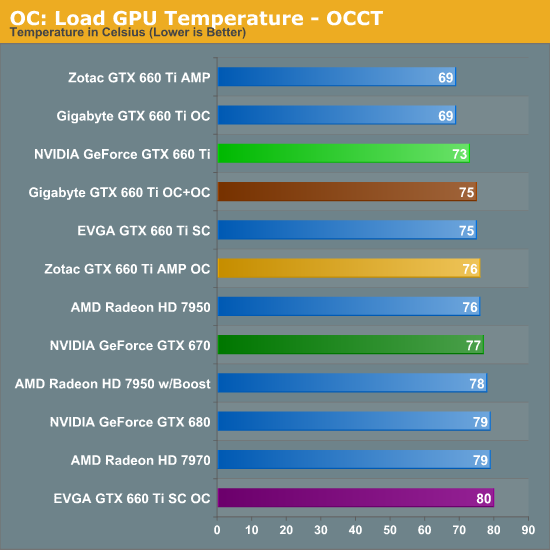
We also see the usual increase in load temperatures due to the increased power consumption. The Zotac and Gigabyte cards fare well enough due to their open air coolers, but the blower-type EVGA card is about as high as we want to go at 80C under OCCT.
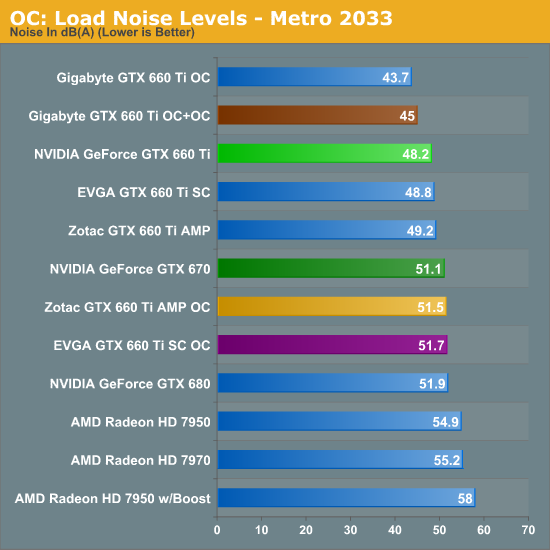
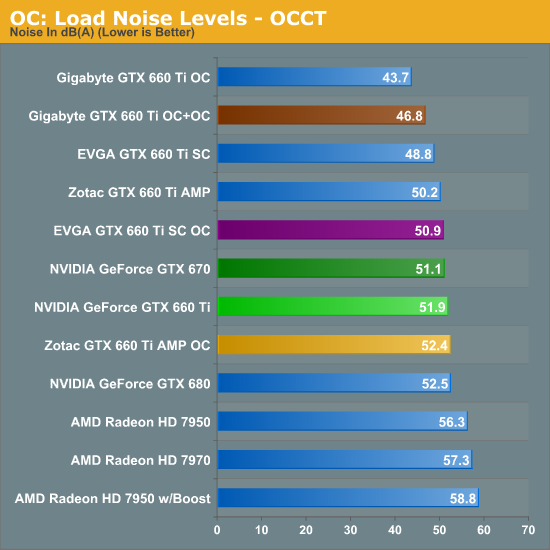
Last but not least, looking at noise levels we can see an increase similar to the temperature increases we just saw. For the Zotac and EVGA cards noise levels are roughly equal with the reference GTX 680, which will be important to remember for when we’re looking at performance. Meanwhile the Gigabyte card continues to shine in these tests thanks to its oversized cooler; even OCCT can only push it to 46.8dB.










313 Comments
View All Comments
CeriseCogburn - Saturday, August 25, 2012 - link
nVidia= "drivers fixed immediately"amd= " drivers not fixed for years, and broken fixing something else"
JM Popaleetus - Thursday, August 16, 2012 - link
Ryan,Can we expect some benchmarks and data in regards to the 660 and further overclocking?
Ryan Smith - Thursday, August 16, 2012 - link
Going up now.bill4 - Thursday, August 16, 2012 - link
When I just checked newegg and there are no 660 TI in stock?Or for that matter, that 680 was impossible to find for *months*? Why is that OK? I saw NO reviewers ever nick Nvidia for that one...
Ryan Smith - Thursday, August 16, 2012 - link
Hi bill;That's a reasonable question.
First and foremost, it's 7am in the morning. Newegg doesn't always post stock updates this early, so GTX 660 Ti cards may not show up until a bit later in the day. Though EVGA already has their cards up on their site.
As for our concerns about launch availability, it's the difference between what is being claimed and what is being delivered. NVIDIA told us right from the start that the supply of the GTX 680 would be tight, and that's exactly what happened. AMD told us that the 7970GE would be available in late June, and that did not happen.
Mind you, AMD isn't having supply issues either. The 7970GE wasn't late because AMD was having any kind of trouble supplying partners with suitable GPUs.
antef - Thursday, August 16, 2012 - link
I got badly bitten this generation by the classic "new products are just around the corner" conundrum. I wanted to upgrade exactly this time last year but didn't because I wanted the new and more efficient 28nm AMD cards that were supposedly just around the corner. Instead, they came late and were a huge letdown: too expensive and not the kind of performance boost I was expecting. Then NVIDIA countered but only focused on the high-end for all these months. However it did seem that NVIDIA had the better, more efficient product. So I was waiting for their card in the $200-300 range and finally after a whole year it's here.The price is a bit high, but I'm tired of waiting and will probably jump on this. I like the cool and silent operation of the Gigabyte but Ryan speaks highly of the ZOTAC as well, not sure which to get.
Should I jump on this as soon as I see retail availability?
just4U - Thursday, August 16, 2012 - link
I have to disagree.. they were not a letdown at all.. Price seemed to be the only major complaint people were having. But in a way AMD has been on the ball. Their a step ahead of Nvidia in getting next gen products out and a half step behind in performance. To me that seems pretty good.rarson - Friday, August 17, 2012 - link
Yeah, and price was only an issue because people were ignoring economic and manufacturing factors and making unreasonable expectations.CeriseCogburn - Sunday, August 19, 2012 - link
Yeah sure there rarson, it wasn't AMD in a fit of corporate piggery and immense greed scalping the crap out of us and abandoning the gaming community for as long as they could possibly keep selling their junk at a huge inflated price.....Oh wait.... it was.
Galidou - Monday, August 20, 2012 - link
And would you stop exaggerating with your conspirations and overpriced SHIT language all over the place. What hurts the most in the past if we speak about pricing stupidity is probably buying an i7-980x cpu for 1100$ and then one week later sandy bridge gets out and tramples the cpu at 220-300$ price points with an i5-2500k and i7-2600k... speak about inflated prices for pieces of hardware that must cost not even 30$ to manufacture.Nvidia as any other company isn't being nicer, it's still based on maximum profit. They probably sell video cards that costs 20$ to manufacture and beleive me the profit doesn't go into funding environmental projects to get rid of all the electric wastes we create every year.
They pay developpers like any other company to get games optimized for their hardware and what's happening now, reduces our choices depending on the games we play. They still ask reviewers to ensure their products have the best performance in their reviews. That's, to me, liying to the consumer(US) so they sell more stuff. Even if their product is good(which they are), that's still manipulating the opinion, thus they do not work for the people, they work for the profit.
So... please, stop speaking about Nvidia like if everything they do has been decided by god before and thus is perfect in every way... it doesn't work. You won't be a better human nor be more happy if you play more game thanks to the performance of your video card, you'll just end up being more addicted and that's it.